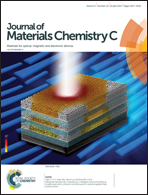Electrochemiluminescence resonance energy transfer (ERET) towards trinitrotoluene sensor based on layer-by-layer assembly of luminol-layered double hydroxides and CdTe quantum dots†
Abstract
Electrochemiluminescence (ECL) resonance energy transfer (ERET) systems have shown excellent potential in analysis and detection fields because of its supersensitivity, high level of controllability, and amplified signal. Herein, a solid film sensor (described as (3-AMS-CoAl LDHs/CdTe QDs)n) was fabricated layer-by-layer by assembling positive luminol (3-AMS)-layered double hydroxide (LDH) nanoparticles and negative CdTe quantum dots (QDs), which produces an effective ERET from luminol (donor) to QDs (acceptor). The ECL intensities of luminol and QDs are enhanced simultaneously, which can be related to the sensitization of QDs and occurrence of ERET, respectively. The optimized ECL intensity of the thin film (3-AMS-CoAl LDHs/CdTe QDs)10 (pH = 7.5) can be obtained by tuning the pH and cycle number (n). Moreover, the (3-AMS-CoAl LDHs/CdTe QDs)10 modified electrode shows good sensitivity and selectivity towards trinitrotoluene (TNT) detection based on the ratiometric ECL signal, which could open up an effective way to apply solid ERET films in trace ECL sensors.



 Please wait while we load your content...
Please wait while we load your content...